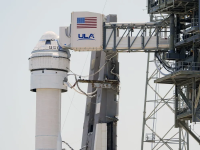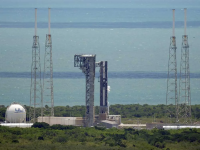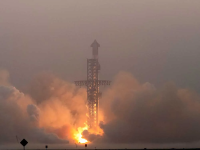Boeing’s first astronaut flight now set for June after review of small leak
Author of the article:Associated Press
Associated Press
Marcia Dunn
Published May 24, 2024 • 1 minute read
Boeing's Starliner capsule
Boeing's Starliner capsule atop an Atlas V rocket is seen at Space Launch Complex 41 at the Cape Canaveral Space Force Station Tuesday, May 7, 2024. PHOTO BY JOHN RAOUX /THE ASSOCIATED PRESS
CAPE CANAVERAL, Fla. — Boeing is now aiming for its first astronaut launch at the beginning of June, after spending the past few weeks struggling with more problems on the space capsule.
Officials for the company and NASA said Friday that intensive reviews indicate the Starliner capsule can safely fly with two test pilots, despite a small propulsion system leak. The helium leak was discovered following the first launch attempt on May 6 that was scuttled by an unrelated rocket problem that has been fixed.
Engineers suspect a defective seal that, even if the leak worsens, could be managed in flight. Boeing is targeting June 1 for the launch from Florida.
Identification of the leak led to the discovery of a “design vulnerability” in Starliner’s propulsion system in the unlikely event of a string of failures, said Steve Stich, NASA’s commercial crew program manager. The team has developed workaround methods to get the capsule safely out of orbit at flight’s end if such problems arise, he added.
“We’re not going to fly until we’re sure we’re safe,” NASA Associate Administrator Jim Free told reporters.
Boeing’s Starliner capsule is already years late in transporting astronauts to the International Space Station for NASA. SpaceX has been launching crews since 2020. NASA wants both companies for backup taxi service.


 torontosun.com
torontosun.com
Author of the article:Associated Press
Associated Press
Marcia Dunn
Published May 24, 2024 • 1 minute read
Boeing's Starliner capsule
Boeing's Starliner capsule atop an Atlas V rocket is seen at Space Launch Complex 41 at the Cape Canaveral Space Force Station Tuesday, May 7, 2024. PHOTO BY JOHN RAOUX /THE ASSOCIATED PRESS
CAPE CANAVERAL, Fla. — Boeing is now aiming for its first astronaut launch at the beginning of June, after spending the past few weeks struggling with more problems on the space capsule.
Officials for the company and NASA said Friday that intensive reviews indicate the Starliner capsule can safely fly with two test pilots, despite a small propulsion system leak. The helium leak was discovered following the first launch attempt on May 6 that was scuttled by an unrelated rocket problem that has been fixed.
Engineers suspect a defective seal that, even if the leak worsens, could be managed in flight. Boeing is targeting June 1 for the launch from Florida.
Identification of the leak led to the discovery of a “design vulnerability” in Starliner’s propulsion system in the unlikely event of a string of failures, said Steve Stich, NASA’s commercial crew program manager. The team has developed workaround methods to get the capsule safely out of orbit at flight’s end if such problems arise, he added.
“We’re not going to fly until we’re sure we’re safe,” NASA Associate Administrator Jim Free told reporters.
Boeing’s Starliner capsule is already years late in transporting astronauts to the International Space Station for NASA. SpaceX has been launching crews since 2020. NASA wants both companies for backup taxi service.


Boeing’s first astronaut flight now set for June after review of small leak
Boeing is now aiming for its first astronaut launch at the beginning of June, after spending past few weeks struggling with more problems
![sask-space-junk-20240530[1].jpg sask-space-junk-20240530[1].jpg](https://forums.canadiancontent.net/data/attachments/20/20569-bcf6c01e8df941c33f13d0074b93b61d.jpg)







![boeing-starliner[1].jpg boeing-starliner[1].jpg](https://forums.canadiancontent.net/data/attachments/20/20717-ef6ac5e57840fa13ed3371a57803841c.jpg)









